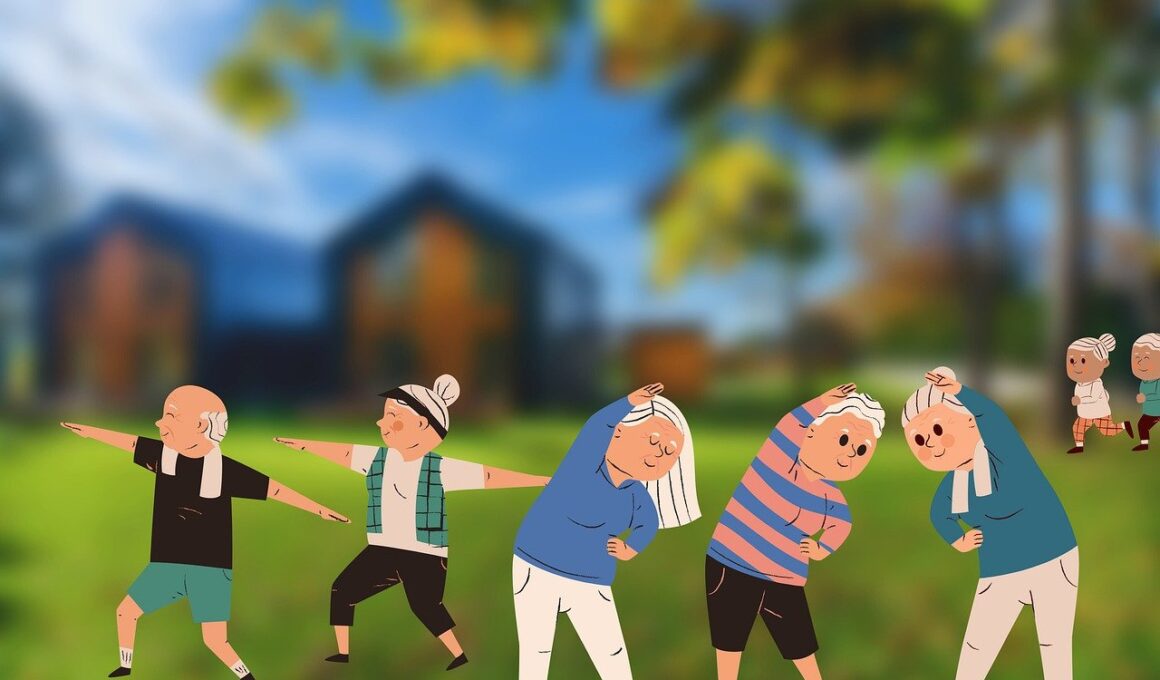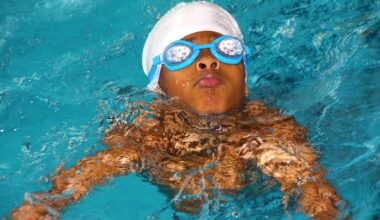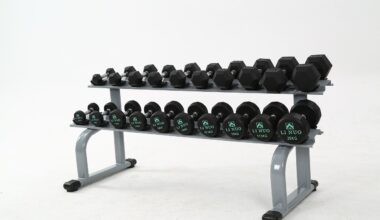Beginner’s Guide to Dance Fitness for Older Adults
Dance fitness is an engaging way for older adults to improve their physical health, enhance mood, and socialize. By participating in dance fitness classes, seniors can experience cognitive stimulation alongside physical exercise. Such classes are designed to be low-impact yet captivating, ensuring ample fun without risking injury. Dance fitness caters to various skill levels – even beginners can join and enjoy the benefits. Music typically employed in these classes often evokes nostalgia and is a significant motivation for participation. Not only does it brighten spirits, but it can also quickly transport seniors back to joyous memories of their youth. Team-building is another essential aspect of dance fitness. Engaging in group sessions fosters camaraderie among participants. This positive social interaction encourages individuals to stay committed to their fitness journeys. Instructors often guide students through movements tailored to their abilities, building confidence. All these aspects combine into a holistic approach aimed at enhancing overall health. Additionally, dance fitness is easily accessible thanks to many local community centers and online platforms. This accessibility enhances convenience for seniors looking to incorporate dance into their routines.
Starting dance fitness can feel overwhelming, but it’s essential to recognize that the first step is often the most important. Before engaging in dance fitness activities, seniors should consult with healthcare providers or fitness professionals. This ensures personal safety, particularly if there are pre-existing medical conditions. Once cleared, selecting the right class that accommodates individual preferences and physical limitations can improve comfort levels. Beginners should explore various styles, such as Zumba Gold or line dancing, which are enjoyable yet gentle. Classes should provide a supportive atmosphere where every participant feels welcomed and included. It’s suitable to start slow, dancing to music of a preferred genre that lifts spirits. As participants grow comfortable with movements, they can gradually increase intensity based on personal readiness. Embracing the journey is vital – improvements in strength, flexibility, and balance come over time. Additionally, focusing on personal enjoyment rather than performance eases anxiety. Dance fitness serves as an avenue for self-expression. Rather than merely exercising, seniors can embrace their unique styles and traits. Ultimately, the objective remains to cultivate joy and fulfilment through dance, fostering a lifelong passion for physical activity.
Benefits of Dance Fitness for Seniors
Engaging in dance fitness provides numerous benefits for seniors that contribute to improved wellness. Physiologically, dance fitness assists in maintaining muscle strength, enhancing coordination, and improving cardiovascular health. As older adults immerse themselves in rhythmic movements, they strengthen their core, which promotes better balance and reduces fall risk. Mentally, dance stimulates brain activity, fostering better cognitive function. Studies have evidenced that those who dance regularly often exhibit sharper memory and quicker reaction times. Emotionally, participating in dance boosts mood and alleviates feelings of anxiety or depression. Fostering relationships is regarded as beneficial as well; friendships formed during classes promote a sense of belonging. Additionally, the joy experienced while dancing fosters a positive outlook toward life. Dance fitness enhances flexibility, enabling seniors to engage in daily activities with greater ease. By incorporating stretching routines, participants can further improve overall agility. It’s essential to remember that the enjoyment derived from dance is incredibly therapeutic. With strategies focusing on fun and socialization, older adults find comfort in movement while enriching their lives. Thus, dance fitness emerges as a comprehensive approach to enhancing health and well-being in older adults.
Choosing the appropriate dance fitness instructor significantly impacts the experience. It’s essential to look for instructors certified in dance fitness for seniors. This ensures instructors comprehend the physical requirements crucial for older adults. Moreover, effective communication skills and the ability to provide modifications for different fitness levels are vital traits. A skilled instructor can create a comfortable and inclusive environment. This encourages individual inquiry and expressions during sessions, leading participants to explore self-confidence through movement. Additionally, ensuring that instructors prioritize fun fosters a light-hearted atmosphere. Parents should research class reviews or ask fellow participants about their experiences, promoting informed decisions. Remember to emphasize a learning journey rather than perfection in dance. Adequate encouragement from instructors also inspires perseverance. As participants witness gradual improvement in their skills, they develop resilience. Besides formal classes, seniors may explore at-home options, utilizing online platforms that offer dance fitness tutorials tailored to their needs. These alternatives provide flexibility, catering to personal schedules while embracing fitness. Experimenting with different styles and formats can also keep the experience fresh and engaging. Ultimately, the combination of a suitable instructor and enjoyable content leads to enriching dance fitness experiences.
Creating a Dance Space at Home
For seniors who prefer to dance at home, creating a suitable dance space enhances motivation and enjoyment. Selecting an open area, free from clutter, ensures safety while allowing freedom of movement. Sufficient space reduces the likelihood of injury. Incorporating mirrors can enhance the visual experience, enabling beginners to observe themselves as they learn movements. Ideally, seniors should invest in supportive footwear to aid comfort during dance practices. It’s advisable to wear shoes that keep feet secure while providing adequate arch support. Furthermore, controlling ambient lighting can create a pleasant atmosphere. Natural light or warm-toned lamps can significantly uplift the mood. Engaging with music that resonates personally transforms the space into a vibrant dance haven. Social media platforms can also provide great ideas for home dance workouts. By viewing tutorials or participating in live classes, seniors can stay connected to the dance community from their living spaces. Setting regular dance schedules can reinforce commitment and develop dance as a consistent routine within daily life. Finally, inviting family or friends to join creates a joyful experience while encouraging socialization, further enriching the overall dance fitness journey.
Incorporating a warm-up and cool-down routine before and after dance fitness sessions cannot be overstated. Warm-ups prepare the body for movement, gradually increasing heart rates and promoting better circulation. Engaging in simple stretches and gentle movements protects joints and muscles, reducing risk during workouts. Likewise, cool-down activities such as deep breathing and slow stretching assist in transitioning the body back to a resting state. Recognizing the importance of hydration enhances overall fitness quality. Seniors should always keep water accessible, especially during and after workouts, ensuring proper hydration levels. Staying hydrated supports energy levels, reduces fatigue, and promotes overall health. Listening to one’s body is essential throughout dance fitness journeys. Individuals should learn to recognize their limits and modify movements when necessary. Ignoring fatigue or discomfort can lead to injuries, countering the numerous benefits dance fitness offers. Achieving physical fitness through dance should always prioritize personal enjoyment. The aim remains cultivating a sustainable, joyful way of staying active. Participants should remember that even subtle movements count. Engaging in dance less intensely can still yield significant benefits. Ultimately, focusing on feelings of joy and fulfillment remains paramount for successful dance fitness activities in seniors.
Staying Motivated and Engaged
Maintaining long-term engagement in dance fitness requires creativity and motivation. Setting achievable goals is important to track progress over time. Establishing both short-term and long-term objectives can foster motivation and provide a sense of accomplishment. Participating in challenges or themed dance classes can add excitement and variety to routines. Connecting with other participants outside the class further cultivates friendships, enhancing commitment. Additionally, using apps or tools to track progress and milestones can help participants visualize their achievements. Regularly attending classes builds a routine. Regular fixtures in the schedule foster commitment, contributing to enjoyable experiences over time. It’s also essential to celebrate all achievements, however small; this acknowledgment boosts morale and helps in maintaining motivation. Changing dance styles or instructors can add novelty, rekindling interest in dance fitness. Prioritizing joy over performance creates a fulfilling experience, emphasizing the social aspects. Seniors should explore community or online events celebrating dance fitness, fostering a sense of belonging and camaraderie. From workshops to special events, these gatherings often create inspiring platforms for participants. Emphasizing connection with others represents a fundamental aspect of staying motivated throughout the dance fitness journey.
Finally, it’s important to reflect on the overall experience with dance fitness. Achieving personal fitness goals while savoring joyful moments can create powerful memories. Building a supportive community and fostering friendships enhances the journey significantly. As older adults immerse themselves in dance fitness, they find unique methods of self-expression through movement while discovering exciting new eras of life. Additionally, personal growth can unfold as skills improve, boosting confidence and self-esteem. This newfound confidence encourages seniors to engage in additional physical or social activities. Dance fitness fosters enthusiasm for a healthier lifestyle while encouraging the pursuit of enjoyable activities. The versatility of dance means there’s a style for everyone, ensuring continued engagement and enjoyment. Embarking on a dance journey is a commitment to health and happiness. Therefore, seniors are encouraged to embrace all dimensions of dancing freely. Ultimately, dance fitness serves as more than a form of exercise; it’s a holistic approach to well-being, enabling older adults to thrive emotionally, socially, and physically. Moreover, the memories formed while dancing will last for a lifetime, providing immense joy and fulfillment to individuals.


